Female Pattern Baldness
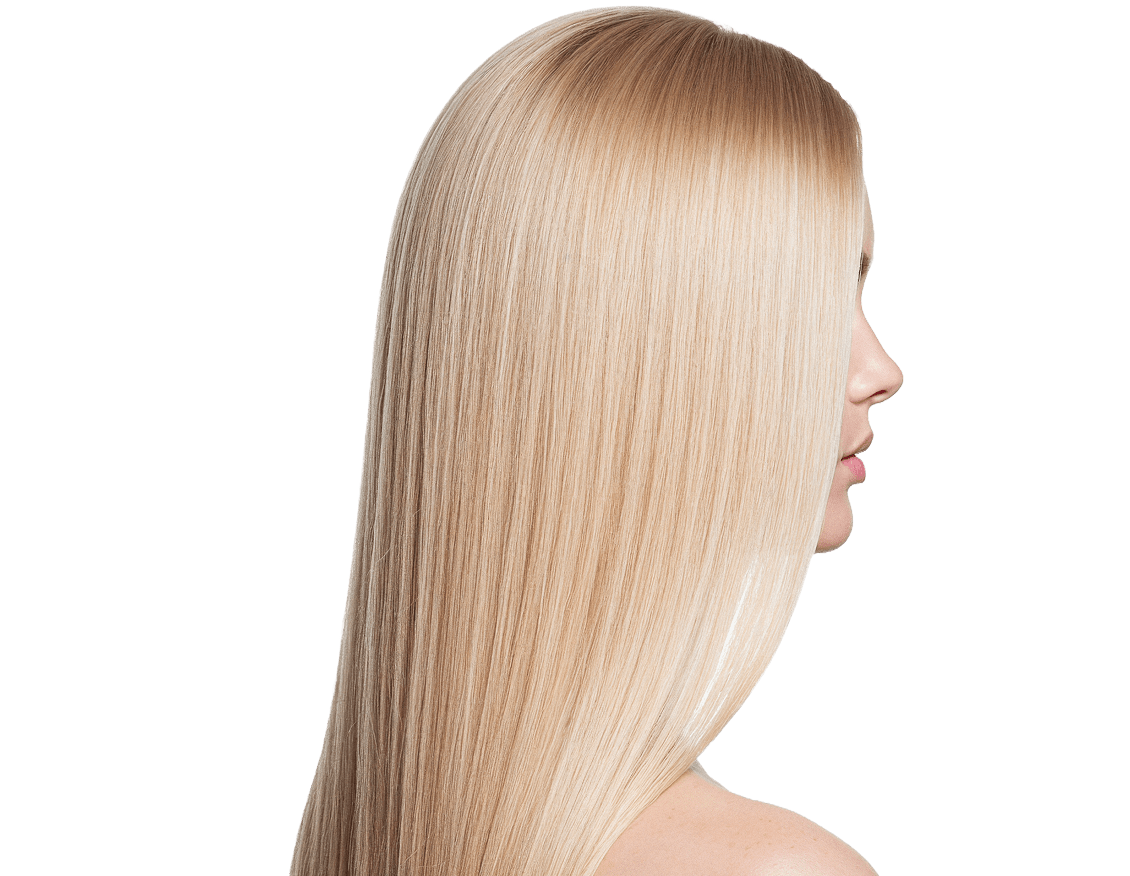
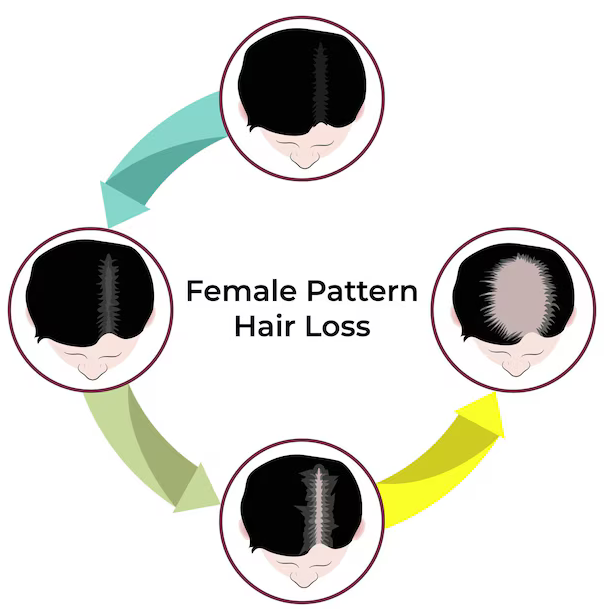
Understanding Female Pattern Baldness
Female Pattern Baldness—also referred to as Alopecia Areata in some cases—is a common form of hair loss affecting women, particularly around the crown and parting line. It tends to progress gradually and doesn’t often lead to complete baldness, but it can be emotionally distressing and impact confidence.
It’s important to understand that hair transplant treatment is not a recommended solution for this condition. Unlike other types of hair loss, female pattern baldness is not typically caused by a lack of follicles in the affected area but by genetic and hormonal factors that lead to follicle miniaturisation.
Because this condition is medical rather than surgical, the best course of action is to consult a qualified dermatologist. They may use a tool called the Ludwig Scale to assess the extent of the thinning and determine a suitable treatment plan. This may include topical or oral medications, PRP therapy, or lifestyle modifications—depending on your specific diagnosis.
If you haven’t yet, visit our hair loss page for a broader overview of the causes and solutions.
What Causes Female Pattern Baldness?
Female pattern baldness is largely hereditary, but genetics aren’t the only factor. A key element lies in how hormones interact with your hair follicles—particularly androgens like testosterone and dihydrotestosterone (DHT). While women naturally have lower androgen levels than men, even small hormonal imbalances can trigger significant hair thinning in genetically predisposed individuals.
One possible genetic influence is the aromatase gene, which plays a role in converting testosterone into oestrogen within the hair follicle. If this conversion is disrupted, higher androgen activity can cause follicles to shrink and produce finer, shorter hairs over time.
Other risk factors include:
- Hormonal changes (e.g. menopause, PCOS)
- Family history of hair thinning
- Underlying autoimmune or thyroid conditions
- Prolonged emotional or physical stress
Types of Hair Loss in Women
Hair loss in women can stem from several causes, each with its own pattern and implications. Female Pattern Hair Loss, also called androgenic alopecia, is the most common type and usually presents as gradual thinning at the crown and parting line. It’s hereditary and often becomes more noticeable with age, though women typically retain strong donor hair at the back of the scalp—ideal for transplants.
Alopecia Areata is an autoimmune condition where the body attacks its own hair follicles, resulting in patchy bald spots. It can affect the scalp, eyebrows, or even beard in rare cases, and is often linked to conditions like coeliac disease, rheumatoid arthritis, or Type 1 diabetes.
Stress-Related Hair Loss occurs when physical or emotional trauma—such as surgery, childbirth, or bereavement—triggers a temporary shedding phase. Similarly, lifestyle habits like extreme dieting, hair-pulling (trichotillomania), or tight hairstyles can also cause thinning. These types of hair loss may resolve over time with better health management and proper care.
In all cases, identifying the underlying cause is essential to recommending the most effective treatment or transplant approach.
How to Recognise Hair Loss in Women
Hair thinning in women often begins gradually, making it easy to overlook in the early stages. Subtle changes such as a widening part, increased hair fall during brushing or washing, or a visible reduction in hair density at the crown may signal the onset of female pattern hair loss. Some women may also notice patches of thinning or sudden shedding triggered by stress, hormonal shifts, or underlying health conditions.
- Thinning along the parting– A visible widening of your natural parting
- Increased shedding– More hair than usual on your pillow, hairbrush, or in the shower
- Patchy bald spots– Especially in cases of alopecia areata
- Itching or discomfort– May suggest scalp conditions or autoimmune triggers
- Change in texture– Hair feels finer, weaker, or harder to style
If you’re noticing any of these symptoms, it’s best to consult a specialist before the condition progresses. Early intervention can often slow or even reverse hair loss, depending on the cause.
The Stages of Female Pattern Baldness
The Ludwig Scale is used to assess the severity of female pattern hair baldness. It categorises the condition into three main stages:
- Type I – Mild Thinning: Thinning is mostly confined to the top of the scalp. The parting may appear slightly wider, but can usually be concealed with styling.
- Type II – Moderate Hair Loss: Hair volume decreases noticeably. The scalp becomes more visible through the hair, especially under light.
- Type III – Advanced Hair Loss: Extensive thinning or baldness at the crown. Hair may remain dense at the back and sides, making them potential donor areas for a hair transplant.
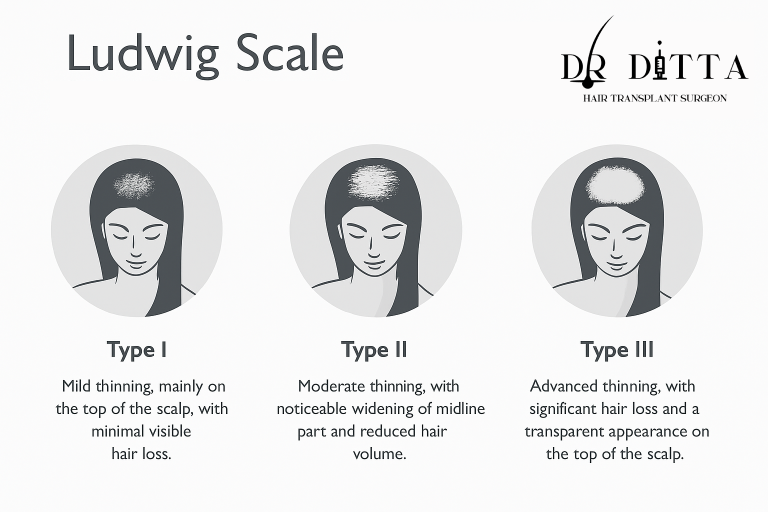
What Is Alopecia?
Alopecia is the medical term for hair loss and refers to a number of conditions that cause thinning or bald patches in men and women. It can occur gradually—like pattern baldness—or suddenly, as seen in autoimmune forms like alopecia areata.
Pattern baldness is the most common type. It typically progresses in a predictable way and is measured using the Norwood Scale (men) and Ludwig Scale (women). This type usually results in permanent hair loss, which may require treatment such as PRP therapy or, in some cases, a hair transplant.
Alopecia areata, on the other hand, leads to sudden patchy hair loss. It’s an autoimmune condition, where the body attacks its own hair follicles. Regrowth is possible in many cases, but recurrence is common.
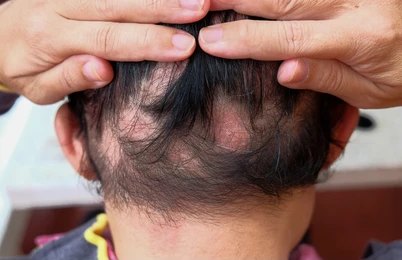
Will Hair Grow Back After Alopecia?
It depends on the type.
In pattern baldness, regrowth is unlikely without medical intervention.
In alopecia areata, regrowth may occur naturally, though future flare-ups are possible.
How Can Alopecia Be Treated?
Treatment is based on the cause of your hair loss. At Dr Ditta’s clinic, we offer:
FUE Hair Transplants – A minimally invasive procedure where individual follicles are transplanted from thicker areas to thinning zones.
DHI Transplants – A more advanced technique using Choi pens for direct implantation, ideal for precise hairline restoration.
Non-surgical options – Such as PRP, minoxidil, and tailored medical advice for autoimmune-related hair loss.
Hair loss treatments
A variety of proven treatments are available for individuals experiencing hair loss. The most effective option for each person depends on the cause, extent, and pattern of their condition. Here are some popular options:
- Hair Transplant Surgery — Considered the most effective solution for permanent hair loss, this procedure involves transplanting healthy hair follicles from a donor area to thinning or bald patches.
- Minoxidil — Available as a topical solution or oral tablet, Minoxidil boosts blood circulation in the scalp and is effective for various types of alopecia.
- Corticosteroids — Topical creams or injections that reduce inflammation and are particularly effective for autoimmune-related hair loss like alopecia areata.
- Low-Level Laser Therapy (LLLT) — A non-invasive laser treatment that stimulates the scalp at the cellular level, supporting healthier follicles and new growth.
- Change in texture– Hair feels finer, weaker, or harder to style

Hair loss prevention
Some forms of alopecia are temporary and can be prevented with the right approach. If your hair loss is linked to factors such as poor nutrition, chronic stress, or damaging styling habits (like excessive heat or tight hairstyles), making simple lifestyle changes can help protect and restore your hair. Addressing these causes early can significantly reduce the risk of long-term thinning or shedding.
- Eat a balanced, nutrient-rich diet with enough protein, vitamins, and iron to fuel hair growth.
- Avoid excessive heat styling and harsh chemicals like bleach and permanent dyes that weaken hair.
- Keep hairstyles loose to avoid stress on the scalp (avoid tight buns, braids, or extensions).
- Quit smoking and limit alcohol—both can restrict blood flow to the scalp and follicles.
- Use stress-management techniques like yoga, mindfulness, or therapy to avoid hair fall linked to anxiety.
- Consult your GP or a trichologist to rule out underlying causes like thyroid issues or nutrient deficiencies.
What Can Women Do to Treat Hair Loss?
When it comes to long-term solutions, nothing compares to the effectiveness of a hair transplant. Many women come to us after trying other methods—such as chemical treatments, supplements, or scalp micropigmentation—with limited or temporary results.
At Dr Ditta Hair Transplant Clinics, we specialise in diagnosing and treating all types of female hair loss with personalised care and surgeon-led solutions. Our goal is to make advanced treatment accessible, offering affordable options and flexible payment plans to suit your needs.
Our available procedures include:
- FUE Hair Transplants – A minimally invasive technique that transplants your natural hair for permanent regrowth.
- Direct Hair Implantation (DHI) – A precision method ideal for more delicate areas, such as the hairline or crown, requiring no shaving.
- Eyebrow Transplants – Perfect for reshaping or restoring sparse or thinning brows with natural-looking, long-term results. Ask ChatGPT
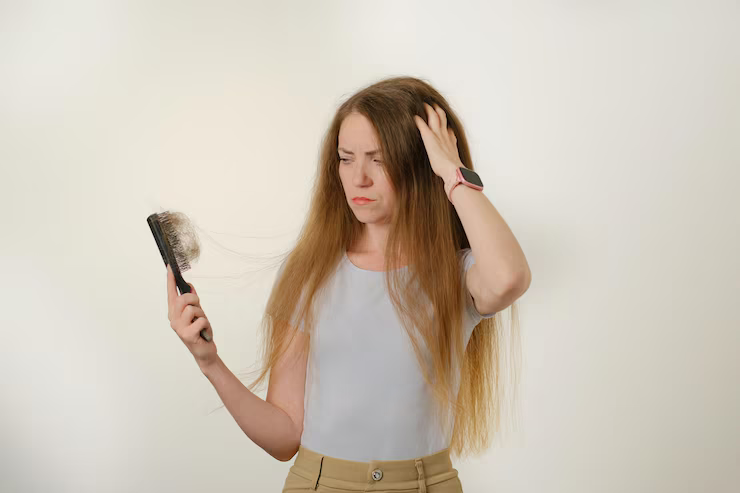
Finding the Right Hair Loss Treatment
Our team has more than 5+ years of experience treating all kinds of hair loss conditions. Whether you’re looking for hair transplant guidance, or you want to try medical therapy first, get free, impartial advice from our friendly team either online by video or face to face at one of clinic locations. We take your unique hair loss experience into account to find the most appropriate and effective treatment for you.
